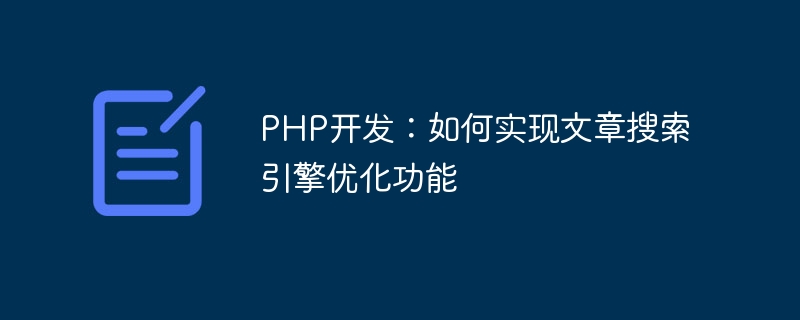Home >Backend Development >PHP Tutorial >PHP development: How to implement article search engine optimization functions
PHP development: How to implement article search engine optimization functions
- WBOYWBOYWBOYWBOYWBOYWBOYWBOYWBOYWBOYWBOYWBOYWBOYWBOriginal
- 2023-09-21 15:18:151477browse

PHP development: How to implement article search engine optimization function, specific code examples are required
Introduction:
In today's Internet era, SEO (Search Engine Optimization, Search engine optimization) has become a very important job, especially for website operators. Article search engine optimization is one of the important components of SEO. It can help website articles obtain better search engine rankings, thereby increasing the exposure and traffic of articles. This article will introduce how to use PHP to develop and implement article search engine optimization functions, and provide specific code examples.
1. Keyword Optimization
- Use keywords in the article title
Keywords play a very important role in the article title. It can tell search engines that this article The main content of the article, so make sure the article title contains keywords related to the article topic. The following is a sample code:
<?php $keyword = "PHP开发"; // 替换成实际的关键词 $title = "如何实现文章搜索引擎优化功能"; // 替换成实际的文章标题 $optimizedTitle = str_replace($keyword, "<span class="highlight">$keyword</span>", $title); echo $optimizedTitle; ?>
In the above sample code, we use the str_replace function to replace the keyword with a span tag with the highlight class, so that the search engine will replace the key when displaying the search results. Words are highlighted, thereby increasing the visibility of the article.
- Use keywords in article content
In addition to the article title, keywords should also be used appropriately in the article content. Note that keywords should be naturally integrated into the article rather than being forced into it. The following is the sample code:
<?php $keyword = "PHP开发"; // 替换成实际的关键词 $content = "这是一篇关于PHP开发的文章"; // 替换成实际的文章内容 $optimizedContent = str_ireplace($keyword, "<span class="highlight">$keyword</span>", $content); echo $optimizedContent; ?>
In the above sample code, we use the str_ireplace function to replace keywords in the article content, and use the span tag of the highlight class to highlight the keywords.
2. URL optimization
- Remove irrelevant characters
When generating the URL of an article, some irrelevant characters, such as spaces and special characters, should be removed. The following is the sample code:
<?php
$title = "如何实现文章搜索引擎优化功能"; // 替换成实际的文章标题
$url = preg_replace("/[^a-zA-Z0-9]+/", "-", $title);
echo $url;
?>In the above sample code, we have used regular expressions to replace non-letter and non-numeric characters with hyphens, which can generate a more friendly and readable URL.
- Add keywords
In order to further optimize the URL, we can add keywords to the URL. The following is the sample code:
<?php
$keyword = "PHP开发"; // 替换成实际的关键词
$title = "如何实现文章搜索引擎优化功能"; // 替换成实际的文章标题
$url = preg_replace("/[^a-zA-Z0-9]+/", "-", $title);
$optimizedUrl = $url . "-" . $keyword;
echo $optimizedUrl;
?>In the above sample code, we add keywords to the end of the URL, which allows search engines to better understand the content of the article.
3. Page title and description optimization
- Page title optimization
Thetag of a web page is very important. It is important for search engines to identify and classify web pages. One of the basis. The following is the sample code:
<?php $title = "如何实现文章搜索引擎优化功能"; // 替换成实际的文章标题 $optimizedTitle = $title . " - 网站名称"; // 替换成实际的网站名称 echo $optimizedTitle; ?>
In the above sample code, we combine the article title and the website name as the title of the page, which allows search engines to better understand the theme and content of the web page. .
- Page description optimization
The description attribute in the tag of a web page is also very important. It can provide search engines with a concise description of the web page and help search engines and users understand the nature of the web page. content and themes. The following is a sample code:
<?php $description = "这是一篇关于如何实现文章搜索引擎优化功能的文章"; // 替换成实际的文章描述 echo "<meta name="description" content="$description">"; ?>
In the above sample code, we use the tag to set the content of the description attribute, which allows search engines to display the description of the web page when displaying search results. information.
Summary:
This article introduces how to use PHP development to implement article search engine optimization functions, and provides specific code examples. Keyword optimization, URL optimization, and page title and description optimization are very important parts of article SEO optimization. I hope this article can be helpful to everyone when optimizing article SEO. Through continuous optimization and improvement, we can allow our articles to achieve better rankings in search engines, thereby attracting more users to visit and read.
The above is the detailed content of PHP development: How to implement article search engine optimization functions. For more information, please follow other related articles on the PHP Chinese website!

